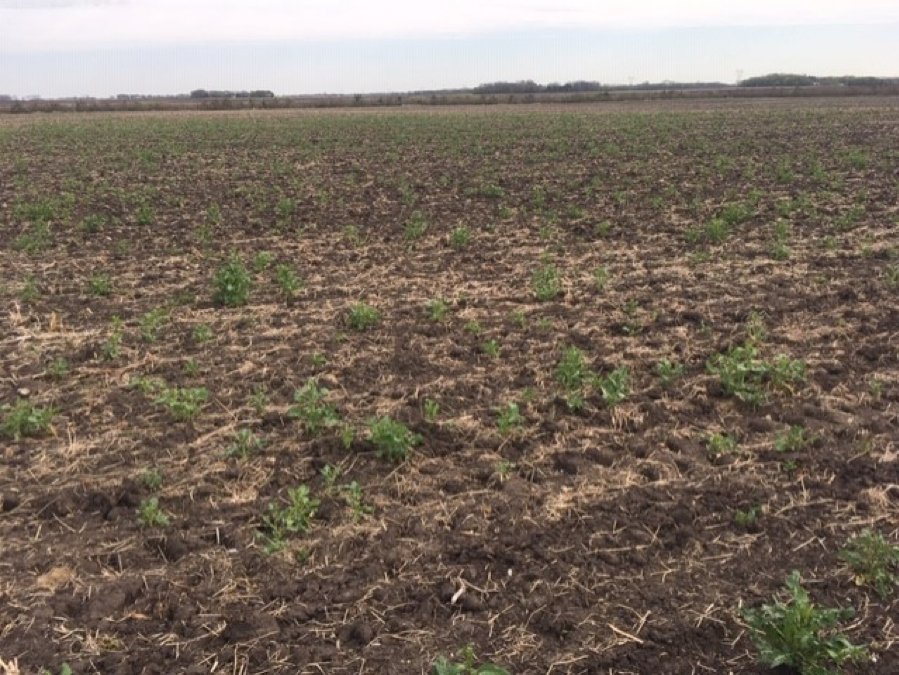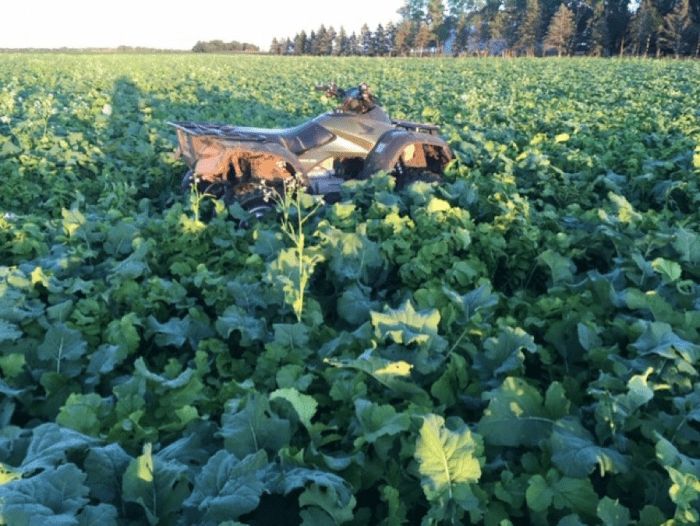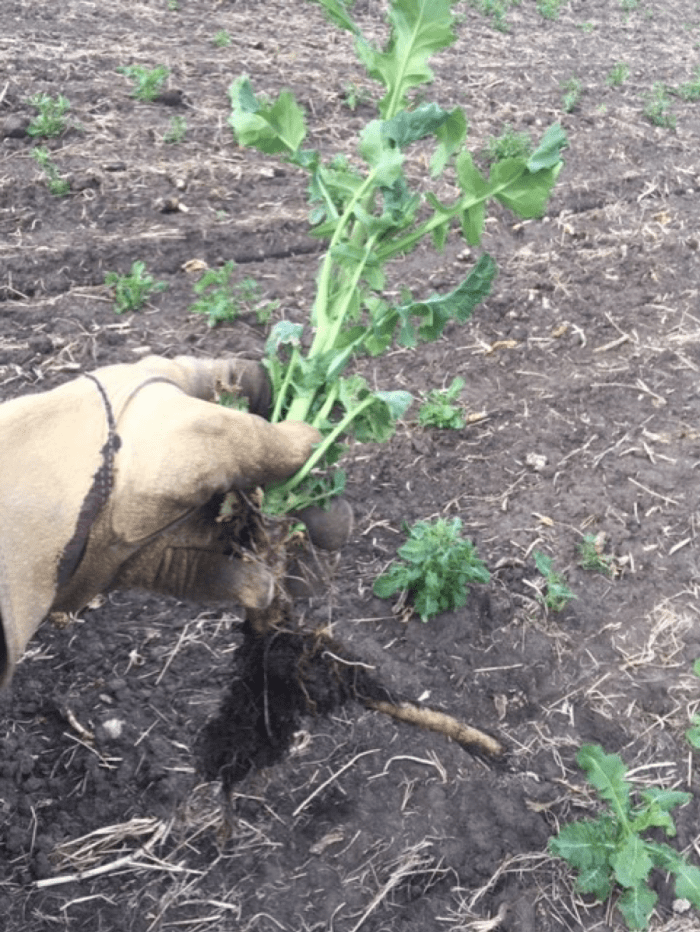Nine Things That Can Go Wrong with Cover Crops: Prevention and Management
By Matt Leavitt, Organic Lead and Agronomist, and Margaret Smith, PhD, Agronomist
Research and practical on-farm experience demonstrate that cover crops work for nearly all farm systems. They improve soil health, soil productivity, water quality, and long-term environmental health; however, any new management practice brings learning opportunities and unintended consequences – and cover crops are no exception.
With proper planning, those unintended disadvantages of cover crops will be less frustrating and more of free educational experience to better position your farm for success moving forward.
We’ve identified nine unintended consequences that may arise with cover crops and a discussion of solutions.
9 Unintended Consequences in Cover Crops
Here’s the quick list of 9 Unintended Consequences in Cover Crops, but scroll down to read about each one more in-depth.
- Seeding Challenges & Poor Stand
- Unexpected Overwintering
- Winterkill When You Expected Winter Survival
- Plugged Drainage Tile Lines
- Contaminating the Following Crop
- Reseeding & Competing with Crops
- Insect & Disease Host/Pressure
- Allelopathy
- Residue Management
It’s easy to look at beautiful green fields of cover crops and be frustrated by your own attempts. Depending on the species in question, the time of year you seed, how you seed and the weather conditions; cover crop stands can sometimes be spotty or inconsistent from year to year.
This can be especially true when cover crops are broadcast, flown on, interseeded into standing crops or seeded outside of the recommended planting windows.
Solution
The more you can treat your cover crops like your cash crops, the better your success at establishment. The more you can plant or drill your cover crops at the right time, optimum depth, right rate, with good seed-to-soil contact, the better establishment you’ll have. Keep an eye on the weather and try to time seedings with forecast rains. Keep your cover crop planting within the appropriate planting window.
The issue that sparked this post was a communication from a grower in Danvers, Minnesota whose daikon radish and/or Dwarf Essex rape overwintered. It was planted in mid-July on Prevent Plant ground fertilized for corn.
We normally expect radish, Dwarf Essex rape (and other fall-planted cover crops like turnips kale, annual ryegrass, and crimson clover) to consistently winterkill, especially that far north. We’ve learned that early planting (before Aug. 1st), mild winters, and abundant fertility can lead to cover crops overwintering. This grower had a vigorous stand going into the fall which likely led to some brassicas overwintering. He had to use additional herbicides this spring to prevent the brassicas from competing with his corn.
We have heard other reports from growers in MN and IA of brassicas overwintering as well.
CC2 and Radish in the Fall of 2019
Same field in the Spring of 2020 with overwintered brassicas.
Solution
Try to prevent this problem by planting brassicas after August 1. If you are a conventional farmer and you have this problem, thankfully most cover crop species are very susceptible to standard burndown herbicides so a single pass will usually control any overwintering species. Annual ryegrass can be more stubborn to kill but timing application at the right growth stage should control any escape. There are exceptions, though.
Dick Sloan, in northeast Iowa, has had Dwarf Essex rape overwinter in the past and has tried several herbicide strategies for control:
Spring herbicides add extra expense, but the soil benefits should outweigh any temporary control costs for conventional operations.
For organic producers, a spring light tillage pass should control most overwintering species. In addition, some organic producers may design cover crop mixes with fewer brassicas and annual ryegrass (depending on planting date, rate, and intended fall/spring tillage).
Fall-planted winter rye, and camelina reliably overwinter in the Upper Midwest. Hairy vetch, Austrian winter pea, and crimson clover all have the potential to survive the winter. Cover crops that winter kill when you expect them to survive are a disappointment, but not devastating.
Susceptibility to winter kill for winter-hardy cover crops varies by species. Fall planting date, biotype, winter conditions and latitude are all factors affecting survival.
- For winter rye, planting before mid-August in the Upper Midwest can lead to too much vegetative growth in the fall and susceptibility to winterkill. Conversely, seeding rye extremely late can also lead to spotty stands as seed will germinate at different times and can winterkill or die from lack of moisture.
- For hairy vetch, seeding mid-August to mid-September with a spring or winter small grain enhances winter survival potential. Later planting often results in winterkill. For northern growers, select biotypes adapted to and grown in the north.
- Austrian winter pea and crimson clover almost never overwinter in the Upper Midwest. They are winter annuals adapted in far southern Iowa, central and southern Illinois and further south.
Solution
If you experience winterkill in your cover crop you can explore a spring planting but the amount of benefit you gain is directly related to how early you seed and when your cash crops need to be planted. If you plant corn in April there is simply not enough growing degree units to capture much of any benefit from spring planted covers. Keep seed costs low; oats are usually a safe, inexpensive bet for early spring planting. For weed management, an additional tillage pass or herbicide treatment may be needed. Organic growers hoping for nitrogen fixation from spring-planted legumes are likely going to have to substitute manure or switch to a crop that require less N.
In the future, pay attention to species selection, planting date and biotype adapted to your region.
Any species with extensive root systems can potentially plug tile lines, especially those that are close to the soil surface on heavy or poorly drained fields. This characteristic is not unique to cover crops; any plant (including corn, alfalfa, annual ryegrass, radish and weeds) can plug tile lines. It’s important to note that this is a fairly uncommon occurrence, especially given how many acres of tiled ground are planted to cover crops every season.
This mainly happens in areas where tiles are bellied, flattened or the grade is inconsistent; areas where water and sediment accumulate can invite root growth from any plant type. As a general rule, roots won’t grow into air so properly installed tiles are essential. Cover crops (like radish) can greatly enhance drainage and so, again, the benefits outweigh the risks in most cases.
Solution
Lower seeding rates of radish and ryegrasses in mixtures if you’re concerned about species plugging tile lines. Delaying planting can also be a tactic to lessen deep rooting; but keep in mind, deep roots are part of the benefit of cover cropping; especially on poorly drained ground.
Frozen tile lines can also be a culprit for poor tile drainage. If you have concerns position cover crops away from fields with shallow or improperly installed tile.
More Info
- Tiles and Cover Crop Roots, Purdue University
- Farmers Respond to Cover Crop Roots Plugging Tile Lines, Practical Farmers of Iowa
Growers that raise small grains need to be aware of which cover crops they’re using in rotation, especially ones that can overwinter and/or set seed including winter rye, hairy vetch, buckwheat, mustard, etc.
Food-grade oats, wheat and barley can be rejected at the mill or processing plant for the presence of winter rye, vetch and other contaminating crops.
Solution
Pay close attention to where you are positioning small grains fields and avoid winter rye, hairy vetch, and other seed-producing species (or species that can shed hard seed) in rotation before planting small grains.
Cover crops species can be prolific seed producers. Some species will germinate soon after seed shed, such as oats and rye. Others, such as buckwheat, red clover and hairy vetch contain a percentage of hard seed and may not germinate until the following spring. The following crop and plans for weed management dictate whether or not this may become a problem.
Solution
Know your cover crop! Will seed overwinter and germinate the following spring or will most germinate the same year the seed is produced? For easiest management, control cover crops before seed set. If seeds do set and germinate monitor new seedling growth and adjust weed control strategies as needed. Reseeded cover crops can sometimes be an advantage in the late summer, after small grains for example.
Cover crops can be a magnet for both beneficial insects as well as insect pest species. Insect pests can be attracted to green fields of cover crops and potentially create issues for the following cash crop. This is especially true with green fields in a landscape with little other cover (like a field of rye early in the spring). It’s hard to say specifically how cover crops will influence crop insect pests as severity and incidence can be influenced by the type of cover crop, planting date, termination date, timing of planting cash crop after termination, weather and environmental conditions, and site history.
Wireworms, seed corn maggot, black cutworms, armyworms, slugs and other species all thrive on green cover crop material, particularly grassy species, and can be detrimental to cash crop seed or newly emerging plants.
Timing and behavior differ for these insect species. Wireworms lay eggs in grassy crops or cover crops mid-summer. Black cutworms and army worms fly into the upper Midwest each spring from wintering ground in the southern U.S. to lay their eggs on grasses or crop residue. Seed corn maggot adult flies are attracted to rotting plant materials, such as tilled cover crops and manured fields in the spring to lay their eggs.
Can cover crops contribute to crop diseases? This has not been widely documented, other than in a few key instances. Pythium root rots and fusarium can be transferred from winter rye to a following corn crop. In addition, some cover crop species, including crimson clover, pea, sweetclover, hairy vetch, alsike clover and cowpeas, are alternate hosts for soybean cyst nematode.
Solution
Know your insect and disease life cycles. The University of Minnesota, University of Wisconsin, and Iowa State University track armyworm and black cutworm moth flights into the upper Midwest each spring. Monitor their websites for information about when to begin scouting for larval feeding in corn and small grain fields.
For best insect and disease management, avoiding planting cover crops and the following crop that are in the same plant family. For example, in the grass family: avoid rye before corn or oats before wheat. In the legume family, avoid crimson clover before soybeans. Corn, in particular, has suffered both disease and insect pest issues when following rye or wheat cover crops.
Organic growers, if tilling in green cover crops should wait 2.5 to 3 weeks to plant to avoid seed corn maggots feeding on corn or soybeans seed.
Producers can, and do, plant into green cover crop residue (like organic producers planting into rolled winter rye) but keep that to relatively weed-free fields and scout the field routinely for armyworms and black cutworms.
More Info
- Insect IPM in Organic Field Crops: Seedcorn Maggot. Holm, K. and E. Cullen
- Cover Crop Induced Insect Problems, Cornell University
- Insects and Cover Crops, University of Nebraska-Lincoln
- The Potential for Cereal Rye Cover Crops to Host Corn Seedling Pathogens, Bakker, M.G., J. Acharya, T.B. Moorman, A.E. Robertson, and T. C Kaspar.
- SCN Soybean Cyst Nematode Plant Management Guide, Iowa State University
Allelopathic compounds are water soluble compounds released into the soil by certain cover crop species (for example, winter rye and to a lesser extent other small grains, brassicas, sorghums and millets) that suppress the germination of small-seeded species. That can be a desirable characteristic of cover crops if your goal is weed control but allelopathic compounds can also suppress cash crops as well.
The degree of allelopathic activity varies from species to species, but it has also been found to vary among rye varieties. Here are general considerations regarding allelopathic compounds:
- Highest concentration in young, green winter rye early in the spring
- Leached from roots and to a lesser degree from top growth
- Water soluble and released rapidly into the soil when cover crops are tilled. Less so if cover crops are chemically terminated
- Greatest impact on small-seeded species. Large-seeded corn, soybeans, and sunflowers are less affected.
Solution
Avoid using cover crops with allelopathic properties in rotation before planting small seeded crops, such as alfalfa, clover and other forage species. Medium-sized seeded crops may also be affected, such as flax.
Corn growth ‘lag’ following a rye cover crop may be due more to cool soil temperature, nitrogen tie up, or to dry soils rather than to the effect of allelopathy but the exact effect can be difficult to accurately measure in the field.
More Info
- Allelopathy and Cover Crops, USDA
- Benzoxazinoids in Rye Allelopathy – From Discovery to Application in Sustainable Weed Control and Organic Farming, National Institute of Health
- Using Allelopathic and Cover Crops to Suppress Weeds, Dalhousie University
No question that residue is what you’re after when you plant cover crops. Living roots in the soil and above ground biomass protect the soil from wind and water erosion, build soil structure and organic matter, and aid in water infiltration. However, cover crops that leave residue have to be accounted and planned for so that they don’t impede tillage, cultivation, fertilizer, or planting equipment, delay field spring or fall field work or interfere with crop growth and development.
Solution
When using cover crops in your farming system, managing residue will be part of your operation. You may need to retrofit equipment to plant through or deal with residue (such as changing coulters, modifying row cleaners and/or press wheels and paying close attention to seed-to-soil contact), change the timing of tillage passes, and change your management practices to accommodate the next crop in rotation ( or even adapt your rotation). Cover crops may need to be terminated earlier to ensure complete kill and desiccation or growers may experiment with fall terminated (either by freezing or herbicides) cover crops to minimize residue management issues. If springs are trending cool and wet, it may be beneficial to kill cover crops earlier to give soils time to warm. The same would be true for dry springs; killing cover crops earlier will conserve soil moisture.
More Info
- Managing Cover Crops in Conservation Tillage Systems, Sustainable Agriculture Research and Education (SARE)
- Spring Management of Cover Crops, University of Minnesota
Unintended Cover Crop Consequences: Knowledge is Power
Unintended consequences are normal in biological systems. These issues are relatively uncommon but it’s important with any management practice to be fully aware of the benefits (which are numerous) and the risks (of which there are some).
Need help setting up your cover crop plan? Having issues with your cover crop?
We’re here to help. Albert Lea Seed’s agronomists can walk you through those scenarios and help devise a rotation that can work for you.
Give us a call at 800-352-5247 or email us at albertleaseed@albertleaseed.com



